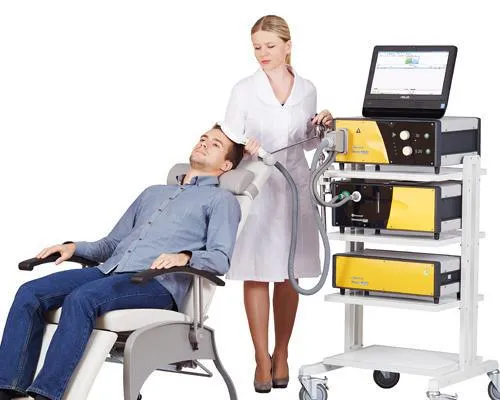Address
440 West Street, Suite 318 Fort Lee, NJ 07024
Contact
Hours
Mon - Fri: 9am - 9pm Sat - Sun: Closed
Transcranial Magnetic Stimulation (TMS Therapy) is redefining how we treat depression and other mental health conditions—without the need for daily medication. As a non-invasive, FDA-approved treatment, TMS Therapy uses targeted magnetic pulses to stimulate specific areas of the brain responsible for mood regulation. For individuals struggling with medication-resistant depression or intolerable side effects, this modern approach offers real, sustainable results.
TMS Therapy is a non-drug, outpatient treatment that stimulates underactive regions of the brain using magnetic fields. Unlike antidepressants that affect your entire body, TMS delivers focused energy directly to the prefrontal cortex—linked to mood, decision-making, and emotional regulation.
Precision treatment: Only the areas of the brain involved in depression are targeted.
No systemic side effects: TMS doesn’t cause weight gain, fatigue, or sexual dysfunction.
Proven results: Clinical studies show significant improvements—even full remission—in patients with treatment-resistant depression.


While antidepressants can help some individuals, many find them ineffective or difficult to tolerate. They often come with side effects like weight gain, fatigue, emotional numbness, or sexual dysfunction, making daily life feel even harder. That’s why more people are turning to TMS Therapy as a safer, longer-lasting alternative.
TMS is completely non-invasive and drug-free, meaning it doesn’t affect your entire body, just the specific areas of the brain involved in mood regulation. Unlike medication, which can take weeks to work (if it works at all), many patients report improvements within just a few sessions.
With minimal side effects, lasting results, and insurance coverage available, TMS empowers you to treat depression at the source, without the emotional fog that often comes with pills. It’s not just another treatment. It’s a smarter, targeted approach to mental wellness.
Get help with depression today! It’s important to know that you are not alone.
Studies of TMS have examined its therapeutic potential for treating various diseases, with depression being the most thoroughly studied. In the late 1990s, researchers worldwide published more than 20 randomized, controlled trials studying TMS as a depression treatment. Now, more and more research continues to emerge around the many beneficial uses for TMS, for depression and beyond.
Research indicates TMS Therapy to be beneficial in treating depression, anxiety, obsessive-compulsive disorder, post-traumatic stress disorder, attention deficit hyperactivity disorder, bipolar disorder, dementia, and more!










Thousands have turned to TMS Therapy for its lasting benefits:
Drug-Free Relief: Ideal for patients with medication intolerance or lack of response.
High Success Rate: Over 60% of patients experience significant symptom reduction.
Sustained Improvement: Relief continues long after the last session.
No Downtime: Return to work or activities immediately after treatment.
Whether you’re facing chronic depression, anxiety, or obsessive-compulsive disorder (OCD), TMS offers a new path forward without the baggage of medication.

TMS is especially effective for individuals who:
Struggle with Major Depressive Disorder (MDD)
Have treatment-resistant depression
Experience intolerable side effects from medications
Seek a natural, non-pharmaceutical approach to wellness
Want to avoid the emotional flatness often caused by SSRIs
You don’t have to suffer in silence or rely on guesswork. TMS provides personalized, data-driven therapy that works with your brain—not against it.
TMS Therapy is performed in a comfortable outpatient setting, with no sedation or hospital stay required.
Consultation & Mapping: Your care team uses MRI-guided technology to pinpoint the exact brain region for stimulation.
Treatment Begins: A magnetic coil placed against your scalp delivers gentle pulses.
Duration: Sessions last about 20 minutes, five days per week for 4–6 weeks.
Zero Recovery Time: You’re free to resume daily activities immediately.
Most patients start feeling improvements within 2–3 weeks of beginning treatment.
Transcranial Magnetic Stimulation (TMS) is a noninvasive procedure that uses magnetic fields to stimulate nerve cells in the brain. It is primarily used as a therapeutic intervention for individuals with certain mental health conditions, particularly those who have not responded well to other treatments.
During a TMS session, an electromagnetic coil is placed against the scalp near the forehead. The coil produces small electric currents that stimulate specific regions of the brain. These magnetic fields pass through the skull and induce electrical activity in the targeted areas. The stimulation can be adjusted in terms of intensity, frequency, and duration, depending on the desired therapeutic outcome.
Scientists have shown that TMS work by altering the activity of brain cells in the targeted regions. By modulating neural activity, it may help to improve mood, alleviate symptoms of depression, and provide relief for other psychiatric disorders. The exact mechanisms of action are still being studied, but it is thought that TMS affects the networks of interconnected brain regions involved in mood regulation and emotional processing.
TMS is commonly used in the treatment of major depressive disorder (MDD), particularly for individuals who have not responded to antidepressant medications. It is also being explored as a potential therapy for other mental health conditions such as bipolar disorder, schizophrenia, and anxiety disorders. In addition to psychiatric disorders, TMS is being investigated for its potential benefits in neurological conditions such as stroke rehabilitation, Parkinson’s disease, and chronic pain.
TMS is generally considered safe and well-tolerated, with minimal side effects. The most common side effects include mild headache and scalp discomfort at the site of stimulation. Serious complications are rare, but there are certain contraindications and precautions to consider. Individuals with metallic implants or devices in their bodies, a history of seizures, or certain medical conditions may not be suitable candidates for TMS.
As with any medical intervention, ethical considerations are important in the use of TMS. Clinicians and researchers must adhere to guidelines and ensure informed consent, privacy, and patient welfare.
While TMS has shown promise as a therapeutic tool, ongoing research and clinical trials are necessary to further understand its potential applications and refine its effectiveness. Advancements in TMS technology and techniques may lead to improved outcomes and expanded uses in the future, including personalized treatments tailored to individual patients.
Transcranial Magnetic Stimulation (TMS) is a noninvasive procedure that involves the use of an electromagnetic coil placed against the scalp to deliver magnetic pulses to specific regions of the brain. These pulses are targeted at the areas involved in mood control and depression. The primary aim of TMS is to activate these regions and restore their normal activity, which may be reduced in individuals with depression.
During a TMS session for depression, the electromagnetic coil is positioned on the scalp, and the coil delivers magnetic pulses. These pulses penetrate the skull and induce electrical currents in the targeted brain areas. By stimulating the nerve cells in these regions, TMS aims to modulate their activity and promote improved mood and a reduction in depression symptoms.
There is another form of TMS called “deep transcranial magnetic stimulation” or “deep TMS.” The difference between standard repetitive TMS (rTMS) and deep TMS lies in the type of coil used. Deep TMS coils are designed to stimulate deeper and wider areas of the brain compared to rTMS. Deep TMS has received FDA approval for the treatment of conditions such as obsessive-compulsive disorder (OCD) and smoking cessation.
While the exact biological mechanisms of TMS are not fully understood, Scientists have shown that the stimulation affects how the brain functions. By targeting and activating specific brain regions, TMS is thought to alleviate depression symptoms and improve overall mood.
As research and knowledge in the field of TMS continue to advance, different methods and techniques may be explored to enhance the effectiveness of the treatment. Experts are continually studying and refining the optimal ways to perform TMS, seeking to improve outcomes and ensure the best possible results for individuals undergoing TMS therapy.
Transcranial Magnetic Stimulation (TMS) is generally considered safe and well-tolerated, but like any medical procedure, it carries some potential risks and side effects. Here are some considerations regarding the risks associated with TMS:
Discomfort or pain at the treatment site: During TMS sessions, some individuals may experience discomfort or mild pain at the site where the electromagnetic coil is placed on the scalp. This discomfort is typically temporary and resolves after the session.
It’s important to note that TMS is a well-studied and widely-used procedure with a good safety profile. Clinicians who administer TMS carefully monitor individuals during treatment to minimize the occurrence of adverse effects. Additionally, TMS is noninvasive and does not require anesthesia or surgery, reducing the risks associated with those procedures.
It’s recommended that individuals considering TMS discuss potential risks and side effects with their healthcare provider to make an informed decision about the treatment. The benefits and risks should be weighed based on an individual’s specific circumstances and medical history.
Before undergoing Transcranial Magnetic Stimulation (TMS), it is important to follow certain preparation steps and inform your healthcare provider about specific factors. Here’s a guide on how to prepare for TMS:
Before your first appointment, it is essential to note that repetitive TMS (rTMS) is a noninvasive procedure that does not require anesthesia. It can be performed on an outpatient basis. While you do not need someone to drive you home after treatment, you may choose to have someone drive you home after the first session to gauge how you feel afterward.
In conclusion, following the necessary evaluations, informing your healthcare provider about relevant medical and health information, and checking insurance coverage will help ensure that you are prepared for TMS and receive the appropriate treatment for your condition.
Transcranial magnetic stimulation (TMS) typically involves a series of treatment sessions to achieve optimal results. Here’s what you can expect during the course of TMS treatment:
It is important to follow the prescribed treatment schedule and attend all scheduled sessions to achieve the desired therapeutic outcomes. Your healthcare provider will monitor your progress throughout the treatment course and make any necessary adjustments based on your response to TMS.
Transcranial Magnetic Stimulation (TMS) has shown promise in improving depression symptoms for individuals who respond well to the treatment. Here are some key points regarding the results of TMS:
It is important to remember that while TMS has shown promising results, it may not be effective for everyone. Individual factors, such as the severity of depression, treatment history, and underlying conditions, can influence the response to TMS. Your healthcare provider will assess your suitability for TMS and discuss the potential benefits and risks specific to your situation.
Overall, TMS offers hope for individuals with depression, with the possibility of experiencing significant improvement in symptoms. Ongoing research and advancements in techniques continue to refine the efficacy and success rates of TMS treatment, providing potential benefits to a broader range of individuals in the future.
After completing a series of Transcranial Magnetic Stimulation (TMS) sessions for depression, ongoing treatment may involve standard care options such as medication and talk therapy. These additional treatments are commonly recommended to provide continued support and manage the symptoms of depression.
However, the use of maintenance TMS sessions to prevent the recurrence of symptoms is still an area of ongoing research. It has not yet been conclusively determined whether maintenance TMS can provide long-term benefits for depression. Maintenance TMS involves continuing treatment even when you are symptom-free, with the hope that it will help prevent the return of depressive symptoms.
If you experience improvement in your depression symptoms with TMS for a period of 2 to 3 months or longer and then later experience a recurrence of symptoms, it is possible to undergo another round of TMS treatment. In such cases, most insurance companies will typically cover repeat TMS treatment.
The decision to repeat TMS treatment will depend on various factors, including the severity of your symptoms, your treatment history, and the recommendations of your healthcare provider. They will evaluate your specific situation and determine the most appropriate course of action.
It is important to maintain open communication with your healthcare provider to discuss ongoing treatment options and any changes or developments in your symptoms. They can provide guidance on the best approach to managing your depression and tailor the treatment plan to your individual needs.
Ongoing treatment for depression often involves a combination of strategies, including TMS, medication, therapy, and lifestyle modifications. By working closely with your healthcare team, you can develop a comprehensive and personalized approach to manage your depression effectively.
440 West Street, Suite 318 Fort Lee, NJ 07024
Mon - Fri: 9am - 9pm Sat - Sun: Closed
HWS Center © 2025 | All rights reserved | For Ketamine Treatment NJ | Created by Invisio Solutions Ltd
We use cookies to improve your experience on our site. By using our site, you consent to cookies.
Manage your cookie preferences below:
Essential cookies enable basic functions and are necessary for the proper function of the website.
Google reCAPTCHA helps protect websites from spam and abuse by verifying user interactions through challenges.
Google Tag Manager simplifies the management of marketing tags on your website without code changes.
You can find more information in our Cookie Policy and Privacy Policy.